Kraków 2014-03-20
7 Tactical Squadron
in Powidz and Świdwin
15.07.1999 year. - 2010 year
History
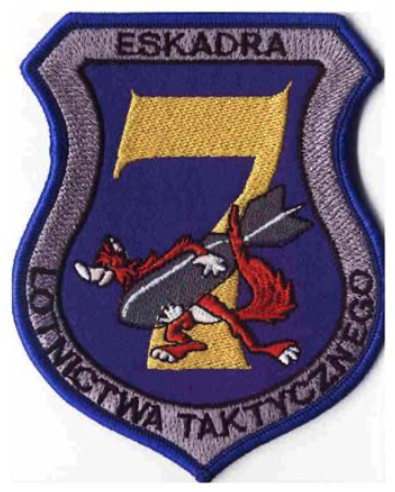
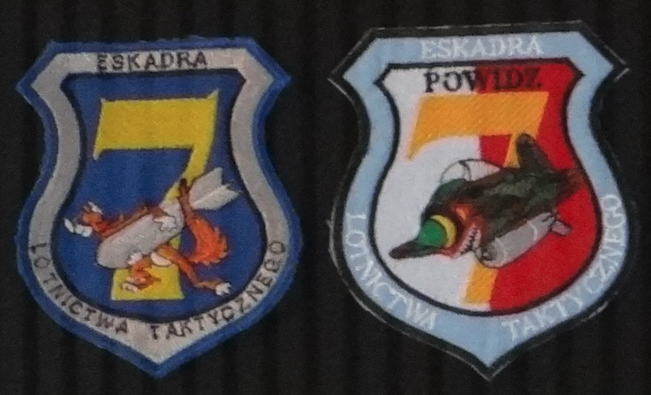
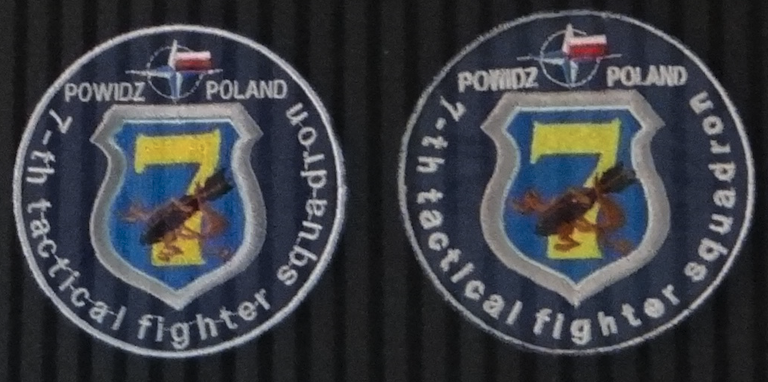
Formation of the 7th Reconnaissance Bomber Regiment. 1999 year.
At the end of the 90s, 7 PLB-R (7th Bomber Reconnaissance Regiment) took place. This was related to Poland's accession to NATO and the transition to the Air Base and Air Squadron system. On the basis of the ordinance of the Minister of National Defense No. PF-74 / Org of 15.07.1999 and Order of the Chief of the General Staff of the Polish Army No. 083 / Org of 09.08.1999, the 7 Tactical Aviation Squadron was established on the basis of 7 PLB-R of a hunting-bomber profile, with its separation to the NATO Rapid Response Force.
Here is the explanation. With the accession of the Republic of Poland to NATO (12/03/1999), not all Polish military units were able to conduct military operations together with NATO forces. It was about communication systems, command structures, tactics and knowledge of English. Therefore, at the time when Poland became a full member of the pact, it already had the minimum required military component capable of interacting with other members of the alliance. This component also contained separate combat aviation units, among them the 7th Tactical Squadron.
7 Tactical Squadron.
The 7th Tactical Aviation Squadron was based at Powidz Airport. Her predecessor was stationed here from 4.07.1957. With the reformation, the Squadron's main combat aircraft were Su-22 M4 aircraft, which arrived in Powidz in 1984.
The squadron was trained in fighting ground targets and tactical reconnaissance. Since its establishment (July 15, 1999), it has been given the task of achieving interoperability with NATO air units. For this purpose, Squadron pilots were trained by instructors from the USA, UK and Canada. They carried out training according to the Combat Ability Achievement Program, the goal of which was to obtain the status of ready for action, known as "Combat Ready". The annual flight time for the pilot was 120 hours. The first four pilots completed training in June 2000. They were it; Major Tadeusz Mikutel, Major Wojciech Stępień, Major Krzysztof Walczak, Captain Grzegorz Węglorz. These pilots also became instructors to train other Squadron pilots. Soon Major Adam Świerkocz joined this group.
In May 2000, four Su-22 aircraft, eleven pilots and ground personnel took part in the international COOPERATIVE BANNERS 2000 flight exercise in Stavanger, Norway. These were the first squadron exercises abroad. On May 29, 2000, the first joint departure of Polish Su-22 and Norwegian F-16 took place. This day was considered a holiday of the individual.
In 2000, the Squadron participated in exercises; COOPERATIVE BANNERS 2000, NATO AIR MEET 2000.
From the beginning of the existence of the Squadron, competition was conducted in it. In 2000, Major Pil was chosen as the pilot of the year. Wojciech Stępień, and the technician of the year was the staff staff. Grzegorz Kalwinicki.
2001 year.
In September-October 2001, Squadron was the first in Poland to pass readiness to act according to NATO procedures. This control is called TACEVAL. During the inspection, the unit was transferred to an operational airport from which it carried out impact missions for military training grounds. All tasks were carried out in accordance with the rules used in NATO, using English as the basic language of command and cooperation. Both flying and technical personnel confirmed their readiness to act in NATO structures.
Squadron pilots (Maj. M. Erdmański, Capt. M. Kejna, Capt. W. Śramkowski) represented the Air and Air Defense Forces three times by performing an individual pilot demonstration on Su-22 during the AIR SHOW air show in Radom in 2001-2003 .
In 2001, Capt. pil. Tomasz Stefaniak, and the young technician of the year was the staff Maciej Buczkowski.
2002 year.
In 2002, the Squadron took part in the STRONG RESOLVE 2002 exercises.
In 2002, Major was elected the pilot of the year. pil. Krzysztof Walczak, and senior technician of the year became senior sick. Sławomir Marszałek.
2003 year.
In 2003, the Squadron took part in the CLEAN HUNTER 2003 exercises.
In 2003, Capt. pil. Wiesław Śramkowski, and the senior technician of the year was the senior staff Piotr Benk.
2004 year.
In 2004, the Eskadra took part in the SENTRY WHITE FALCON 2004, LONE CAT 2004 exercises.
In August 2004, the first part of the Lone Cat 2004 exercise began. Five Su-22 aircraft flew to the Coltishall air base in the UK, along with ground handling. The exercise lasted 10 days, including 5 flying days. Polish planes were training together with 41 RAF squadrons, which operated Jaguar machines. In the second stage of training, planes from 41 RAF squadrons came to Powidz. Polish and British pilots had the opportunity to compare both planes. The more so, as early as in 2006, the RAF decommissioned Jaguar aircraft. In comparison, none of the aircraft achieved a clear advantage over the other. Higher rated Su-22 power unit, due to the greater thrust. It was also easier to aim the Su-22 at the target due to the variable geometry of the wings. But RAF Jaguars have one of the most modern navigation systems, such as those installed on Typhoon planes. Polish pilots have estimated that flying a Jaguar is really fun and is probably easier than a computer game. In addition, the process of preparing the aircraft for flight takes only ten minutes. So, restoring combat readiness is faster.
The conditions of accommodation in the British base made a great impression on Polish staff, which in no way can be compared with the capabilities of Polish air bases. Pilots and officers lived in the officer's mess, whose traditions date back to World War II. Everywhere you could see momentum, big money and rich equipment: computer rooms, multimedia projectors, home cinema sets.
In 2004, Major was elected the pilot of the year. pil. Maciej Trelka, and the technician of the year was platoon. Paweł Błaszczyk.
2005 year.
In 2005, the Squadron took part in the CLEAN HUNTER 2005, LONE CAT 2005, ITALIAN DANCER 2005 exercises.
In June 2005, 7 ELT participated for the second time under the code name Lone Cat 05 as part of the Squadron Exchange program. As in the previous year, four Su-22 went to the UK. This time to the base in Coltishall, where the 6th RAF squadron is stationed, also using Jaguar planes. Mainly CAS tasks were carried out, i.e. the destruction of ground targets. However, the tasks performed were at a higher level. Not only Su-22 and Jaguar planes were in the air, but also Tornado and electronic warplanes. It was a mistake on the Polish side not to send the two-seater version to the UK. Therefore, no reconnaissance flights were carried out in mixed crews.
In 2005, Capt. pil. Tomasz Kozyra, and the technician of the year was Platoon. Krzysztof Papuga.
2006 year.
In 2006, the Squadron took part in the POLISH TIGER 2006 exercises.
On June 19-30, 2006, 7 ELTs participated in the exercise codenamed Polish Tiger, as part of the Squadron Exchange program. The exercise took place at the Italian air base in Amendola, where Polish pilots flew together with the 13th squadron of the Italian Air Force. For 7 ELT it was another flight outside the country. For the second time the Squadron had the opportunity to perform joint air missions with Italian aviation, because in 2005, the 154th squadron of the Italian Air Force visited Poland. Four Su-22 M4 aircraft and one Su-22 UM3K aircraft flew to Italy. A contingent with ground personnel was transferred to three CASA C-295 M aircraft. There were 12 pilots and 38 auxiliary personnel. Polish Su-22 aircraft performed joint flights with Italian AMX, subsonic shock aircraft. MB-139 and F-16 aircraft also participated in the exercise.
In 2006, Capt. pil. Mirosław Jakubowski, and the staff technician of the year was the staff Krzysztof Sochacki.
2007 year.
In 2007, the Squadron took part in the POLISH TIGER 2007, ITALIAN DANCER 2007 exercises.
During the Italian Dancer 2007 exercises, 8 AMX ships of the Italian Air Force flew to the 33rd Air Base in Powidz. The Italians performed joint flights at low altitudes above the Nadarzyce training ground, using Mk.82 bombs, cannons and training bombs guided by laser.
On September 25, 2007, at around 11:20, near Jasień near Czempin during the Polish-Italian exchange "Italian Dancer 2007", the squadron pilot (see G. Gołas) catapulted together with an Italian pilot damaged after collision with the Italian Air Force AMX type birds. The birds were sucked in by the engine air intakes, which led to the engine stalling. Due to the low altitude, the pilots did not have time to try to start the power unit. Both pilots did not hurt. they were taken to the hospital by a Mi-2 helicopter of the SAR group for a check-up, and then returned to the unit in Powidz.
Polish Tiger 2007 exercises were held on June 29, 2007 - July 12, 2007. Three Su-22 aircraft flew to Italy. The goal was the Istrana airport, which is located in the north-east of Italy. Exercises were held at the sea and high mountains.
In 2007, Capt. pil. Hubert Jaroszyński. We didn't find information who became the technician of the year.
2008 year.
In 2003, decisions were made to purchase for the Polish Armed Forces multi-purpose Lockheed (formerly General Dynamics) F-16 combat aircraft. They were chosen as places of their stationing; Krzesiny Airport, Łask Airport and Powidz Airport. Major refurbishment began. Later, it was decided that the 3rd and 6th Squadron would be based on Krzesiny Airport, and the 10th Squadron would be based at Łask Airport. Because for the Polish Armed Forces it became necessary to have large transport aircraft, in the form of C-130 Hercules, that's why it was decided to put them in Powidz. As a consequence, the 7th Tactical Squadron was transferred to the 21st Świdwin Air Base, where 40 Squadron was also stationed, also operating Su-22 aircraft. After some time, the 8th Squadron (Su-22) was also transferred to the 21st Świdwin Air Base. In this way, all other Su-22 machines in Poland were gathered in one air base.
Importantly, the Squadron 7, 8, 40 were not replaced by the planned next F-16 (not necessarily new), which would reduce costs by standardizing equipment. Unfortunately, at that time the Republic of Poland was already under the rule of freemasons-post-communists from the Civic Platform and the Polish People's Party.
It was a very difficult period for 7 ELTs. The squadron from the state of full combat activity passed into the state of waiting for transit to Świdwin. This did not affect the staff's morale well. Many soldiers moved from 7 ELTs to 6 ELTs or 14 ELTrs. In addition, no tasks were removed from the 7 ELTs, although the composition decreased by 30%. It was so that just after the end of one exercise, the same composition was undertaken by others. There were situations when pilots performed several flights a day. By the end of June 2007, the Squadron had already exceeded 1,000 raid hours. It should be noted, however, that all exercises took place in the territory of the Republic of Poland and the Squadron never flew to foreign exercises.
Personnel stabilization was not favored by the new government, which arbitrarily deprived the soldiers of a separation allowance, which was a significant percentage of salary. After the protests, the supplement returned in a changed form.
The move from Powidz to Świdwin started on January 31, 2008. Then the first four planes Su-22 nb 7411, 7412, 9409 and 707, flew to Świdwin. On February 5, 2008, the last Su-22 nb 7410, 9616 and 9204 flew away. The last Su-22 nb 9204 took off at 15:30, after which the pilot made a farewell mower over the CPPS at a height of 5-10 m.
2010 year.
In 2010, 7 ELT was demolished, and its personnel and equipment was taken over by the 21st Tactical Air Base in Świdwin. In fact, it was sanctioning the situation that occurred in 2008.
Commanders of the 7th Tactical Air Squadron:
Lt. Col. Tadeusz Mikutel in January 2000. - July 2001, Lt. Col. Janusz Duda July 2001.-December 2003, Lt. Col. Jacek Łazarczyk. December 2003.-February 2007, Lt. Col. Maciej Trelka February 2007. - June 2008, p.o. Major Marek Ławicki July 2008 - 2010
Command of the 7th Tactical Aviation Squadron in 2007:
Commander - Lt Col Col. pil. Jacek Łazarczyk; Deputy Commander - Maj. Dipl. pil. Maciej Trelka; Chief of Staff - Capt. Piotr Wanicki, MA; Training Head - Capt. pil. Grzegorz Węglorz; Flight Safety Inspector - Capt. pil. Marek Kejna; Chief of Aviation Technology - Capt. Eng. Dariusz Płóciennik.
Planes.
For the entire period of operation of the 7th Tactical Squadron, the basic combat aircraft was the Su-22 shock vehicle. It is a single-engine turbojet-powered aircraft with supersonic speed and variable wing geometry. He appeared in two versions; Su-22 M4 - single-seater, Su-22 UM3K - two-seater. See separate Chapter Su-22.
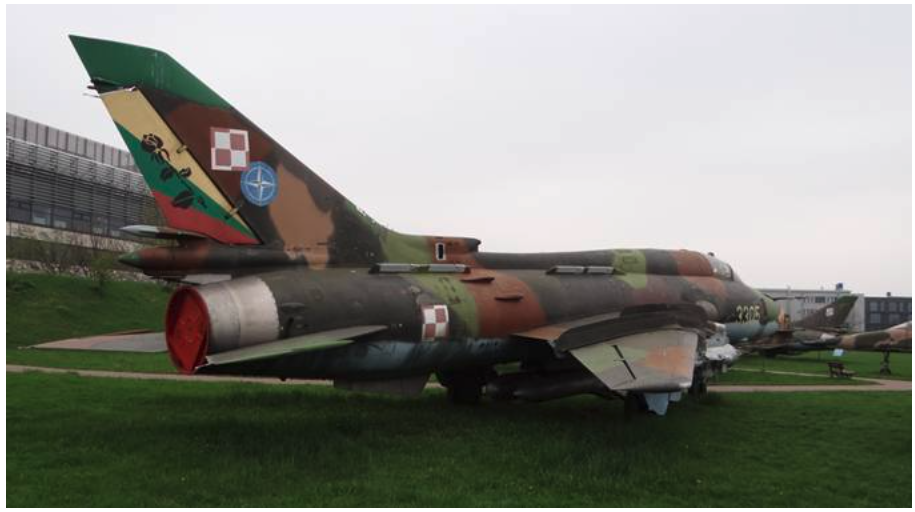
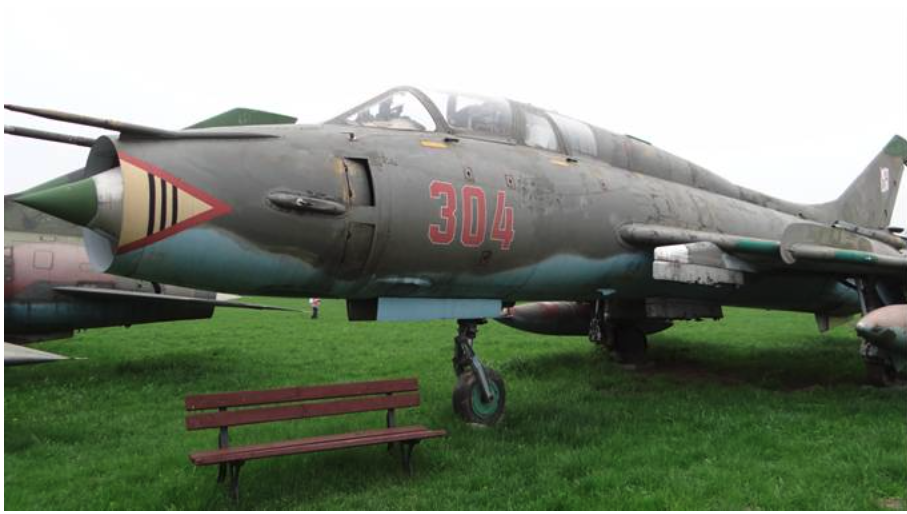
Written by Karol Placha Hetman
